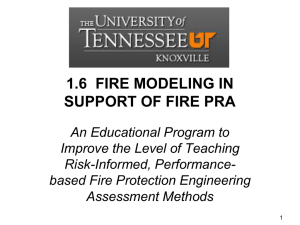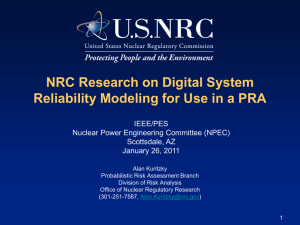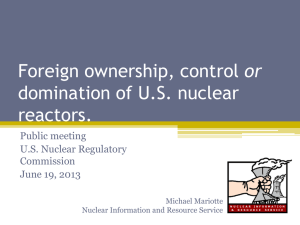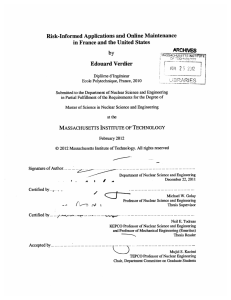Risk and Performance Based NRC Initiatives
advertisement
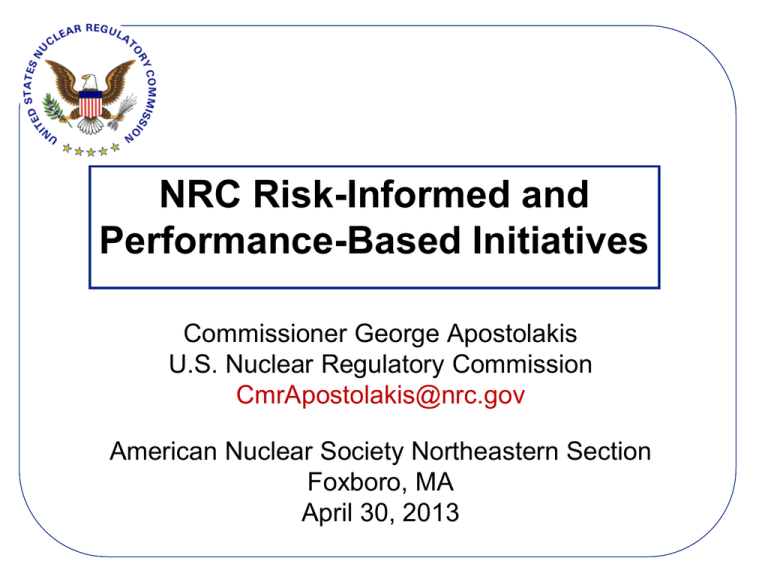
NRC Risk-Informed and Performance-Based Initiatives Commissioner George Apostolakis U.S. Nuclear Regulatory Commission CmrApostolakis@nrc.gov American Nuclear Society Northeastern Section Foxboro, MA April 30, 2013 The Pre-PRA Era • Management of uncertainty (unquantified at the time) was always a concern. • Defense in depth and safety margins became embedded in the regulations. • Design Basis Accidents (DBAs) are postulated accidents that a nuclear facility must be designed and built to withstand without loss to the systems, structures, and components necessary to assure public health and safety. 2 Some Problems • There is no guidance as to how much defense in depth is sufficient • DBAs use qualitative approaches for ensuring system reliability (the single-failure criterion) when more modern quantitative approaches exist • DBAs use stylized considerations of human performance (e.g., operators are assumed to take no action within, for example, 30 minutes of an accident’s initiation) • DBAs do not reflect operating experience and modern understanding 3 Technological Risk Assessment (Reactors) • Probabilistic Risk Assessment (PRA) supports Risk Management by answering these questions What can go wrong? (thousands of accident scenarios are investigated, as opposed to the limited number of DBAs) How likely are these scenarios? What are their consequences? Which systems and components contribute the most to risk? 4 Risk-informed Regulation “A risk-informed approach to regulatory decisionmaking represents a philosophy whereby risk insights are considered together with other factors to establish requirements that better focus licensee and regulatory attention on design and operational issues commensurate with their importance to public health and safety.” [Commission’s White Paper, USNRC, 1999] 5 Risk-Informed Framework Traditional “Deterministic” Approach • Unquantified probabilities •Design-basis accidents •Defense in depth and safety margins •Can impose unnecessary regulatory burden •Incomplete RiskInformed Approach Risk-Based Approach •Combination of traditional and riskbased approaches through a deliberative process • Quantified probabilities •Thousands of accident sequences •Realistic •Incomplete 6 Prior Beliefs: 1. 2. 3. Reactor Safety Study (WASH-1400; 1975) Protect against large loss-of-coolant accident (LOCA) Core damane frequency (CDF) is low (about once every 100 million years, 10-8 per reactor year) Consequences of accidents would be disastrous Major Findings 1. 2. 3. 4. Dominant contributors: Small LOCAs and Transients CDF higher than earlier believed (best estimate: 5x10-5, once every 20,000 years; upper bound: 3x10-4 per reactor year, once every 3,333 years) Consequences significantly smaller Support systems and operator actions very important 7 At Power Level I PRA Results CDF = 4.5x10-5 / yr Initiator Contribution to CDF Total: • Internal Events…………………..56% • External Events ………………….44% Seismic Events Fires Other 24% 18% 2% 8 Quantitative Safety Goals of the U.S. NRC (August, 1986) Quantitative Health Objective (QHOs) Early and latent cancer mortality risks to an individual living near the plant should not exceed 0.1 percent of the background accident or cancer mortality risk, approximately 5 x 10-7/year for early death and 2 x 10-6/year for death from cancer. •The prompt fatality goal applies to an average individual living in the region between the site boundary and 1 mile beyond this boundary. •The latent cancer fatality goal applies to an average individual living in the region between the site boundary and 10 miles beyond this boundary. 9 PRA Model Overview and Subsidiary Objectives CDF 10-4/ry Level I PLANT MODEL LERF 10-5/ry Level II CONTAINMENT MODEL QHOs Level III SITE/CONSEQUENCE MODEL Results Results Results Accident sequences leading to plant damage states Containment failure/release sequences Public health effects Uncertainties PLANT MODE At-power Operation Shutdown / Transition Evolutions SCOPE Internal Events External Events 10 Evolution of the Risk-Informed Regulatory System • Regulatory Requirements – ATWS Rule (1984) – Station Blackout Rule (1988) – Maintenance Rule (1991) • Risk-Informed Changes to the Licensing Basis – – – – Regulatory Guide (RG) 1.174 (1998) Technical Specification Improvement Initiatives Risk-Informed Inservice Inspection Special Treatment/Categorization (“Graded QA”) • Reactor Oversight Process (2000) • Fire Protection (2004) • New Reactor Licensing (2007) 11 Risk-Informed Changes to the Licensing Basis (RG 1.174; 1998) Comply with Regulations Maintain Defense-inDepth Philosophy Maintain Safety Margins Integrated Decision Making Risk Decrease, Neutral, or Small Increase Monitor Performance 12 Benefits • Improves Safety – New requirements (SBO, ATWS) – Design of new reactors – Focus on important systems and locations • Makes regulatory system more rational – Reduction of unnecessary burden – Operating experience accounted for in regulations – Consistency in regulations • Encourages performance-based regulation – Maintenance rule – Fire protection – Determination of seismic design basis motion 13 Fukushima Near-Term Task Force Recommendation 1 • Establish a logical, systematic, and coherent regulatory framework for adequate protection that appropriately balances defense in depth and risk considerations. – Draft a Commission policy statement that articulates a risk-informed defense-in-depth framework that includes extended design-basis requirements in the NRC’s regulations as essential elements for ensuring adequate protection. 14 NTTF Recommendation 1 – Regulatory Framework • Staff developing Options for potential changes to the regulatory framework – Industry input/proposal expected April 2013 – Substantial additional stakeholder interaction planned – NRC staff developing paper for Commission Beyond design basis requirements ?? ?? Risk Management Task Force (NUREG-2150) ?? Recommendation 1 15 Risk Management Task Force (RMTF) Task Force formed in February 2011 “To develop a strategic vision and options for adopting a more comprehensive and holistic risk-informed, performance-based regulatory approach for reactors, materials, waste, fuel cycle, and transportation that would continue to ensure the safe and secure use of nuclear material.” 16 A Proposed Risk Management Regulatory Framework Mission Ensure adequate protection of public health and safety, promote the common defense and security, and protect the environment Objective Manage the risks from the use of byproduct, source and special nuclear materials through appropriate performance-based regulatory controls and oversight Risk Management Goal Provide risk-informed and performance-based defense-in-depth protections to: Ensure appropriate barriers, controls, and personnel to prevent, contain, and mitigate exposure to radioactive material according to the hazard present, the relevant scenarios, and the associated uncertainties; and Ensure that the risks resulting from the failure of some or all of the established barriers and controls, including human errors, are maintained acceptably low Decision-Making Process Use a disciplined process to achieve the risk management goal: Identify issue Identify Options Analyze Monitor Implement Decision Deliberate 17 Deliberation Define appropriate regulatory controls and oversight to meet risk management goal related to risk-informed and performance-based defense in depth Decision Criteria Legal Requirements Resource Implications Stakeholder Views Technical analysis Uncertainties and Sensitivities An organized process of characterizing risk that includes both qualitative and quantitative components (including factors for “unknown unknowns”) PRA PA Complex Facility Infrequent events ISA Qualitative Traditional Engineering Analyses Simpler Facility More frequent events Figure B-4 Technical Analysis Techniques & Deliberation 18 Operating Reactor Recommendations The set of design basis events/accidents should be reviewed and revised, as appropriate, to integrate insights from the power reactor operating history and more modern methods such as PRA. NRC should establish via rulemaking a design enhancement category of regulatory treatment for beyond-design-basis accidents. This category should use risk as a safety measure, be performance-based (including the provision for periodic updates), include consideration of costs, and be implemented on a sitespecific basis. 19 Design Enhancement Characteristics Who decides what is included? • NRC specifies initiators or scenarios • Licensees use site-specific PRAs Proposed Design Enhancement Category What criteria are used for inclusion? • Initiating events with frequency greater than xx • Accident sequences with frequency greater than yy • Cost-beneficial rules What criteria are used for disposition? • Risk less than zz • ALARA • Combination 20 Proposed Regulatory Framework: Power Reactors Design basis event? Adequate protection rule? Current cost-beneficial safety enhancement rule? Included riskimportant scenario? Remaining scenarios Adequate Protection Category Proposed Design Enhancement Category Proposed Residual Risk Category 21 Challenges A change would be required within the agency and externally to increase understanding of the value and use of risk concepts and the risk management language The proposed risk-informed and performance-based concept of defense in depth may require the development of additional decision metrics and numerical guidelines The approach would likely require developing new or revised riskassessment consensus codes and standards Consideration of cost in the design-enhancement category in the power reactor regulatory program would necessitate a reconsideration of the agency’s tools for performing cost-benefit analysis A long-term commitment from the Commission and senior agency management would be required for implementation 22




